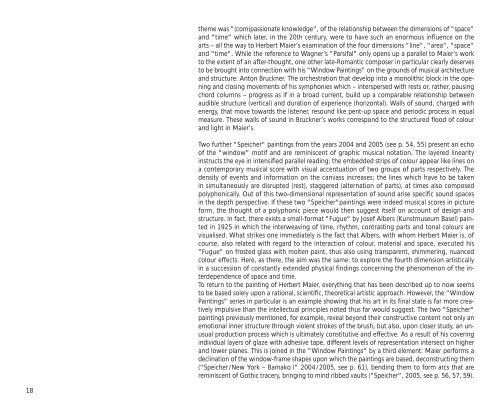Sie wollen auch ein ePaper? Erhöhen Sie die Reichweite Ihrer Titel.
YUMPU macht aus Druck-PDFs automatisch weboptimierte ePaper, die Google liebt.
18<br />
theme was "(com)passionate knowledge", of the relationship between the dimensions of "space"<br />
and "time" which later, in the 20th century, were to have such an enormous influence on the<br />
arts – all the way to Herbert Maier’s examination of the four dimensions "line", "area", "space"<br />
and "time". While the reference to Wagner’s "Parsifal" only opens up a parallel to Maier’s work<br />
to the extent of an after-thought, one other late-Romantic composer in particular clearly deserves<br />
to be brought into connection with his "Window Paintings" on the grounds of musical architecture<br />
and structure: Anton Bruckner. The orchestration that develop into a monolithic block in the opening<br />
and closing movements of his symphonies which – interspersed with rests or, rather, pausing<br />
chord columns – progress as if in a broad current, build up a comparable relationship between<br />
audible structure (vertical) and duration of experience (horizontal). Walls of sound, charged with<br />
energy, that move towards the listener, resound like pent-up space and periodic process in equal<br />
mea sure. These walls of sound in Bruckner’s works correspond to the structured flood of colour<br />
and light in Maier’s.<br />
Two further "Speicher" paintings from the years 2004 and 2005 (see p. 54, 55) present an echo<br />
of the "window" motif and are reminiscent of graphic musical notation. The layered linearity<br />
instructs the eye in intensified parallel reading; the embedded strips of colour appear like lines on<br />
a contemporary musical score with visual accentuation of two groups of parts respectively. The<br />
density of events and information on the canvass increases; the lines which have to be taken<br />
in simultaneously are disrupted (rest), staggered (alternation of parts), at times also composed<br />
polypho nically. Out of this two-dimensional representation of sound arise specific sound spaces<br />
in the depth perspective. If these two "Speicher"paintings were indeed musical scores in picture<br />
form, the thought of a polyphonic piece would then suggest itself on account of design and<br />
structure. In fact, there exists a small-format "Fugue" by Josef Albers (Kunstmuseum Basel) painted<br />
in 1925 in which the interweaving of time, rhythm, contrasting parts and tonal colours are<br />
visualised. What strikes one immediately is the fact that Albers, with whom Herbert Maier is, of<br />
course, also related with regard to the interaction of colour, material and space, executed his<br />
"Fugue" on frosted glass with molten paint, thus also using transparent, shimmering, nuanced<br />
colour effects. Here, as there, the aim was the same: to explore the fourth dimension artistically<br />
in a succession of constantly ex tended physical findings concerning the phenomenon of the interdependence<br />
of space and time.<br />
To return to the painting of Herbert Maier, everything that has been described up to now seems<br />
to be based solely upon a rational, scientific, theoretical artistic approach. However, the "Window<br />
Paintings" series in particular is an example showing that his art in its final state is far more creati<br />
vely impulsive than the intellectual principles noted thus far would suggest. The two "Speicher"<br />
paintings previously mentioned, for example, reveal beyond their constructive content not only an<br />
emotional inner structure through violent strokes of the brush, but also, upon closer study, an unusual<br />
production process which is ultimately constitutive and effective. As a result of his covering<br />
individual layers of glaze with adhesive tape, different levels of representation intersect on higher<br />
and lower planes. This is joined in the "Window Paintings" by a third element: Maier performs a<br />
declination of the window-frame shapes upon which the paintings are based, deconstructing them<br />
("Speicher / New York – Bamako I" 2004 / 2005, see p. 61), bending them to form arcs that are<br />
reminiscent of Gothic tracery, bringing to mind ribbed vaults ("Speicher", 2005, see p. 56, 57, 59).


